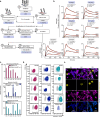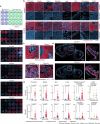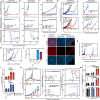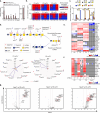Tumor-agnostic cancer therapy using antibodies targeting oncofetal chondroitin sulfate
- PMID: 39215044
- PMCID: PMC11364678
- DOI: 10.1038/s41467-024-51781-0
Tumor-agnostic cancer therapy using antibodies targeting oncofetal chondroitin sulfate
Abstract
Molecular similarities between embryonic and malignant cells can be exploited to target tumors through specific signatures absent in healthy adult tissues. One such embryonic signature tumors express is oncofetal chondroitin sulfate (ofCS), which supports disease progression and dissemination in cancer. Here, we report the identification and characterization of phage display-derived antibody fragments recognizing two distinct ofCS epitopes. These antibody fragments show binding affinity to ofCS in the low nanomolar range across a broad selection of solid tumor types in vitro and in vivo with minimal binding to normal, inflamed, or benign tumor tissues. Anti-ofCS antibody drug conjugates and bispecific immune cell engagers based on these targeting moieties disrupt tumor progression in animal models of human and murine cancers. Thus, anti-ofCS antibody fragments hold promise for the development of broadly effective therapeutic and diagnostic applications targeting human malignancies.
© 2024. The Author(s).
Conflict of interest statement
A.S., M.D., M.Ø.A., T.M.C., M.A.N., and T.G.T. are shareholders of VAR2 Pharmaceuticals. The antibodies are subject to a patenting process owned by VAR2 Pharmaceuticals. H.C. is a shareholder of GlycoDisplay ApS, GlycoZym ApS, GlycoZym Inc, now GO Therapeutics Inc. The remaining authors declare no competing interests.
Figures






References
-
- Baston-Büst, D. M., Götte, M., Janni, W., Krüssel, J.-S. & Hess, A. P. Syndecan-1 knock-down in decidualized human endometrial stromal cells leads to significant changes in cytokine and angiogenic factor expression patterns. Reprod. Biol. Endocrinol.8, 133 (2010). 10.1186/1477-7827-8-133 - DOI - PMC - PubMed
MeSH terms
Substances
Grants and funding
- 9065-00216A/Innovationsfonden (Innovation Fund Denmark)
- NNF22OC0073736/Novo Nordisk Fonden (Novo Nordisk Foundation)
- NNF19SA0059305/Novo Nordisk Fonden (Novo Nordisk Foundation)
- NNF19OC0058387/Novo Nordisk Fonden (Novo Nordisk Foundation)
- CF20-0412/Carlsbergfondet (Carlsberg Foundation)
- DNRF107/Danmarks Grundforskningsfond (Danish National Research Foundation)
- DNRF107/Danmarks Grundforskningsfond (Danish National Research Foundation)
- ALTF 105-2063/European Molecular Biology Organization (EMBO)
- R344-2020-934/Lundbeckfonden (Lundbeck Foundation)
- R324-2019-1855/Lundbeckfonden (Lundbeck Foundation)
- PJT-470421/Gouvernement du Canada | Canadian Institutes of Health Research (Instituts de Recherche en Santé du Canada)
LinkOut - more resources
Full Text Sources
Medical

